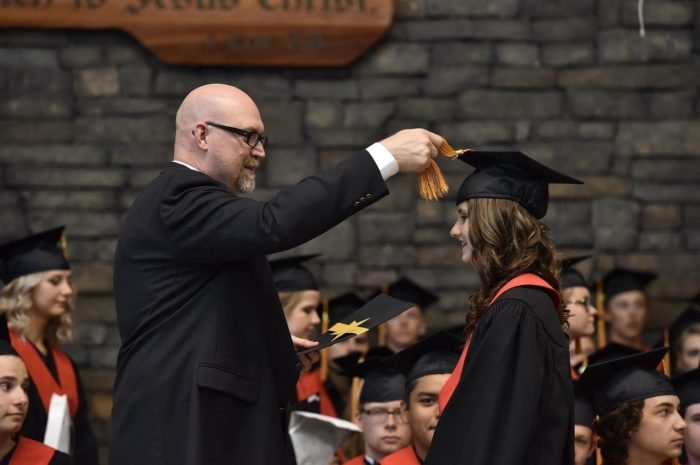Ask 10 people what a liberal arts college is and you’re likely to get 10 different responses. While the term “liberal” is used, the liberal arts are not rooted in politics in any way. And, although the term “arts” suggests that the STEM and business fields would be excluded, this couldn’t be further from the truth.
So what exactly is a liberal arts college then? It’s a four-year institution that focuses on undergraduate programs of study that lead to a bachelor’s degree. Students take a broad range of courses in humanities, arts, sciences and social sciences.
What Makes a Liberal Arts College Unique?
There are several qualities that distinguish a liberal arts college from a university or community college. In general, a liberal arts offers the following qualities:
A Focus on Undergraduate Students
There are usually very low to nonexistent numbers of graduate students at liberal arts colleges. This means that professors are fully dedicated to working with undergraduates, helping them prepare for future studies.
Baccalaureate Degrees
The degrees typically awarded from a liberal arts college are four-year bachelor’s degrees such as a B.S. (bachelor of science) or a B.A. (bachelor of arts).
Small Size
You’ll find that most liberal arts colleges have a student body of less than 5,000. Many are actually in the 1,000 to 2,500 student range. This means smaller class sizes, more personalized attention, and a greater ability to get to know professors and peers on a personal level.
Liberal Arts Curriculum
Instead of focusing on narrow preprofessional skills, liberal arts colleges provide students with broad skills in writing and critical thinking. Students will have a focused major but take a breadth of courses in fields such as psychology, math, religion, literature, philosophy and science. This allows for a wide range of knowledge to be obtained and used in their chosen field.
Teaching is a Priority
At larger universities, professors are typically evaluated for their publishing and researching first and teaching second. But at most liberal arts colleges, teaching is the number one priority.
The History of Liberal Arts Education
During the period of history known as “classical antiquity” between the 8th century BC and 6th century AD, liberal arts was considered essential education for a free individual active in civic life. This education would have allowed someone to participate in public debate, defend themselves in court, and perform military service. At this time in history, liberal arts covered only three main subjects: grammar, rhetoric and logic, collectively known as the trivium.
During the medieval times, this course work was extended to include four additional subjects: arithmetic, geometry, astronomy and music, named the quadrivium. The quadrivium was considerably more difficult than the trivium and used to prepare students for more serious study of theology and philosophy.
The entire aim of liberal arts education “back in the day,” was to produce individuals (mostly men) who were virtuous and ethical, highly articulate and knowledgeable in many fields.
While modern liberal arts curriculums offer even more subjects to study, the core aim still remains, which is to develop well-rounded students that have general knowledge on a wide range of subjects and a mastery of transferrable skills.
What are the subjects now offered at a liberal arts college?
- Humanities – These subjects will include art, literature, linguistics, philosophy, religion, ethics, modern foreign languages, music, theater, speech, and classical languages (Latin/Greek).
- Social sciences – History, psychology, law, sociology, politics, gender studies, anthropology, economics, geography, business informatics, etc.
- Natural sciences – includes astronomy, biology, chemistry, physics, botany, archaeology, zoology, geology, Earth sciences, etc.
- Formal sciences – includes mathematics, logic, statistics, etc.
What is the Admission Process for a Liberal Arts College?
Generally speaking, admissions standards for liberal arts colleges will vary widely from school to school. For instance, some colleges may have open admissions while other colleges may be far more selective.
Most schools, however, will take a holistic approach to their admission process. Because these schools have a strong sense of community, the admission staff will take some time to get to the know the whole applicant, not just their grades and standardized test scores. An equal emphasis will be given to application essays and letters of recommendation as well as extracurricular involvement of the prospective student.
In other words, when applying to a liberal arts college, the admission staff won’t focus solely on “how smart you are,” but rather, will want to deeply understand if you are someone who will contribute to classes and campus life in a positive and meaningful way.
What is a Typical Liberal Arts College Curriculum?
The curriculum at most liberal arts colleges has been designed to provide students with generalized knowledge. Rather than focusing exclusively on their major, students are encouraged to explore a diverse array of subjects and departments. As an example, it is common for, say, an economics major to also be studying philosophy or psychology. Many students that attend liberal arts colleges explore multidisciplinary tracks.
How do Public and Private Liberal Arts Colleges Differ?
Through your research on colleges you may have noticed that a good majority of liberal arts colleges are private, but not all are. And it is worth mentioning that there are some differences between a public and a private liberal arts college. Namely, a public liberal arts college offers:
- State funding: Public colleges are partly funded by taxpayer money, but the majority of operational budget tends to come from tuition and fees.
- Lower cost: You’ll find that tuition at public liberal arts colleges is usually significantly lower than at private colleges. This is particularly true for in-state students. That said, there are many private liberal arts colleges that have large endowments and are able to offer financial aid to students who qualify. If you are looking for additional ways you could save BIG on your college tuition, we’re going to share that with you in a just a bit.
10 Reasons to Consider Attending a Liberal Arts College.
If you’re wondering whether a liberal arts college is right for you, here are some reasons to consider attending one:
-
Undergraduate Focus
Larger universities, such as research universities, spend a lot of their time, energy and resources on research and graduate students. But liberal arts colleges focus their attention on teaching undergraduate students.
-
Access to Professors
The more access a student has to professors, the more likely they will succeed with their studies. The class size at liberal arts colleges is far smaller than at larger universities and students get individual attention. Compare that to larger universities where many courses are taught by assistants who are usually graduate students themselves with very little teaching experience.
At liberal arts colleges, teachers have one-on-one time with students and can therefor serve not just as teachers but as mentors. This is invaluable.
-
Critical Thinking Skills
Critical thinking is perhaps the most valuable skill a college graduate can come away with. Because class sizes are much smaller at liberal arts colleges, there are usually discussions each day that give students the opportunity to hear different perspectives, communicate their ideas and think critically.
-
A Well-Rounded Education
Many larger universities are regimented with very specific curriculum requirements. This rigidity does not allow students to explore other areas of study.
Liberal arts colleges, however, give students the opportunity to take classes in many disciplines such as arts, humanities, socials sciences, natural sciences and math. A liberal arts education’s main goal is to prepare students for a variety of career paths.
-
Preparation for Graduate School
By far more liberal arts graduates attend graduate school than other students. This is because liberal arts curriculums prepare students well for graduate level work because they focus on class participation, writing papers, and thinking critically.
-
Employers Value a Liberal Arts Education
Because a liberal arts curriculum offers students the ability to communicate, analyze, think critically and work in teams, employers tend to look for candidates with a liberal arts degree in their background. The truth is, individuals that can view things from multiple perspectives, no matter their field, provide greater value to employers.
-
High Graduate Program Acceptance
Liberal arts colleges have higher than average numbers of graduates being accepted into top graduate schools including vet school, law school, medical school and engineering programs. These school understand that liberal arts students are better equipped to think, create and develop solutions to problems.
-
Prepares Students for Jobs Yet to be Created
According to the U.S. Department of Labor, “65% of current students will eventually be employed in jobs that have yet to be created, and 40% of current jobs will soon be a thing of the past.”
How does a liberal arts education help these students succeed in an ever-changing world? Because again, their education has focused exclusively on an ability to think, create, collaborate and adapt. These are the hallmarks of liberal arts skills.
-
Helps Students Choose the Best Career Path
When forced at 18 to know exactly what you want to do with the rest of your life, how many of us make the right choice? Because a liberal arts education gives students access to a range of subjects they may have otherwise not encountered, they are able to make a more informed decision about their preferred career path.
-
Helps Adults Make a Career Shift
A liberal arts education can also help adults maneuver from their current career into another one that brings them more joy and bigger earnings potential.
What Careers are Available with a Liberal Arts Education?
Liberal arts students don’t tend to choose a career path at the beginning of their degree. Instead, they learn as much as they can on a variety of topics, which inevitably opens up a plethora of opportunities across many industry sectors.
The following careers are possible with a liberal arts education. While some may require an additional degree, such as a master’s, they all begin with liberal arts:
Academia
Combine the interdisciplinary knowledge with the skills you’ve gained from a liberal arts education and apply these toward your chosen topic.
Art
From photography to commercial art, painting to interior, graphic and visual design, a liberal arts degree will help you share your talent and passion with the world.
Interpreter
Have you always had a fascination with language and other cultures? Many liberal arts students take at least one foreign language class. You could turn this into a career as a translator, interpreter, foreign language teacher or journalist. The world is literally your oyster.
Marketing
The humanities courses you take will help you should you choose to go into marketing. What is marketing, really? It’s communicating with people. Humanities helps you understand people better and the communication skills your education brings will allow you to create the right messages.
Political Science
How would you like a career in law, public policy, politics, business, or working for an NGO or charity?
Biology
How would you like to work in healthcare as a laboratory assistant or research assistant?
Here are some other career paths a liberal arts education can lead to:
- business (entrepreneur, store manager, salesperson)
- event planning
- environment (conservation, public policy)
- finance (banker, accountant, financial analyst)
- law enforcement
- research analysis (combining statistics and psychology)
- social services (counseling or therapy)
How to Save BIG on Your Liberal Arts Education
Historically, adult learners have had less opportunities than high school graduates to obtain a liberal arts education for the simple fact that adult students have work and family responsibilities. This is exactly why I created OnlineDegree.com. I wanted to make college affordable and accessible for everyone.
Students can take as many college-level courses as they’d like for FREE. Study at your own pace, at home, and never have to miss any important family events or work functions. We offer courses in marketing, computer programming, psychology, education, and much more from excellent professors around the country.
Now here’s where the good news gets even better…
You could receive college credit at some of the top liberal arts colleges around the country for the free courses you’ve completed. Not only does this give you the ability to save thousands on your degree, it also allows you to potentially earn your degree much, much sooner. We’ve worked hard to make our courses super interesting, and the ability for those to apply as requirements toward your general education, elective, or degree-specific courses.
Get started in as little as 60 seconds. Find out exactly how you can save and learn.
Related Articles
-
How to Be Successful in College in 2022 – 7 Simple Tips to Succeed
-
How Do Scholarships Work? Read This First…Truth is Shocking
-
7 Best College Majors 2024: What Should I Major In?
-
How to Choose a College – 10 Things You Must Consider in 2024
-
Why Go to College? Top 13 Benefits for Adult Students in 2022
-
Top 5 Best Alternatives to Community College for 2024













